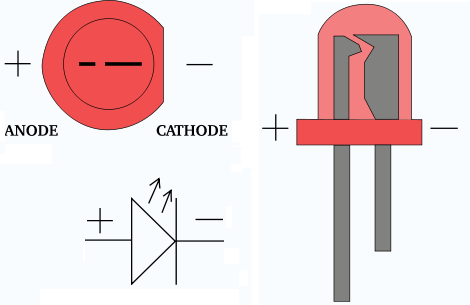Whether you are a seasoned technology enthusiast or a casual layman. If you’ve taken it upon yourself to learn a little more about LED bulbs and how they work, or are just familiar with their characteristics, you may have heard of LED anodes and cathodes. These terms are directly related to the polarity of LEDs and how the technology actually works. While the vocabulary may seem a bit foreign, distinguishing anodes from cathodes is really not as difficult as it sounds.
What is Led?
Since the LED is designed based on a conventional diode, its structure includes the basic elements of a diode. For more functionality, additional elements are added to the LED.
There are two layers of p- and n-type semiconductors inside the LED. They are attached to a substrate terminal that is directly connected to the cathode. The top layer of the semiconductor is connected to the anode by a wire bond.
The body of the LED is made of translucent materials, mostly plastic or glass. Depending on the configuration, the LED can be with additional technical solutions. These are changes in the body (shape, presence of a lens, metal heat sinks) and internal components (several p-n pairs of semiconductors, luminescent filling, control chip, reflector, etc.).
What are led anodes and cathodes?
The anode and cathode are the two terminals on a diode through which electrical current flows. The anode serves as the positive side for an LED, where current enters the diode, while the cathode functions as the negative side, from which the current exits the diode.
How to differentiate between anodes and cathodes?
In order for the LED to function properly in a circuit, it must be connected correctly, which involves determining the location of its cathode (negative) and anode (positive). The anode is typically indicated by a triangle, the cathode by a vertical line, and two parallel arrows indicate that the element emits light. While this labeling is clear, there are other methods for determining polarity.
Visual Definition
To identify the polarity of LEDs in a DIP housing, observe the legs of the LED when purchasing a new one. One leg will be longer than the other, with the longer leg being the anode (positive) and the shorter leg being the cathode (negative). Used diodes, which are soldered, have a cut in the base that indicates where the cathode is located. Alternatively, by examining the internal structure, a wide portion will indicate the negative polarity and a small “detail” will indicate the positive polarity.
SMD Housing
In SMD housing, you cannot examine the internal structure of the LED, but the manufacturer has left a bevel angle as a special mark. The side with the bevel is the cathode (negative), and the opposite side is the anode (positive).
Instrumental Definition
Another method of determining polarity is to use a multimeter, a universal measuring tool. Connect the black probe to the COM connector and the red probe to the VΩmAC connector. Set the regulator to the ringer mode and touch the LED output with the probes. If the red probe touches the anode and the black probe touches the cathode, the LED will illuminate, and the device display will show the voltage drop on the LED. If you have a multimeter with a special connector for PNP and NPN transistors, you can also use this to check the polarity of LEDs. Move the regulator to the “hFE” position and place the LED ends into the connectors marked “E” for emitter and “C” for collector. The LED will light up if the cathode is inserted into the collector socket, as the collector of the PNP transistor has a negative bias. This is one of the quickest and simplest methods for determining the polarity of LEDs.















Leave a Reply